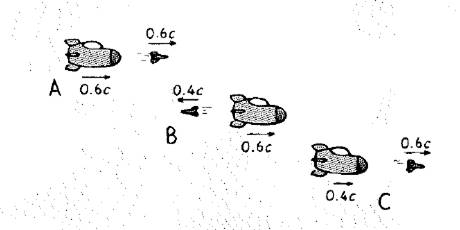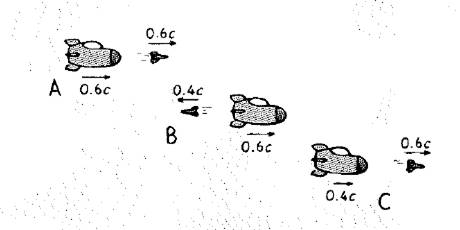
Concept explainers
(a)
To rank:The speeds of the probes as seen by an Earth observer from greatest to least.
(a)
Answer to Problem 17A
The speeds of the probes as seen by an Earth observer from greatest to least is
Explanation of Solution
Given:
The given figure is shown below.

Formula used:
The expression for the speed of the probes as seen by an Earth observer is,
Here,
Calculation:
The speed of the probes as seen by an Earth observer for case A is
The speed of the probes as seen by an Earth observer for case B is,
The speed of the probes as seen by an Earth observer for case C is,
By comparing the speed of the probes as seen by an Earth observer is
Conclusion:
Thus, the speeds of the probes as seen by an Earth observer from greatest to least is
(b)
To rank:The
(b)
Answer to Problem 17A
The speed of light reflected from the departing probes as seen by the spaceship from greatest to least is
Explanation of Solution
Given:
The given figure is shown below.

Formula used:
As per the “second postulate of
Calculation:
The speed of light is constant regardless of the speed of flashlight. It is same in all the reference frames.An observer on the spaceship will measure the speed of light as c .The speed of the flashes will not be different even if the spaceship turns around or stops.Hence, the speed of light which is reflected from the “departing probes” as observed by the spaceship from highest to least is
Conclusion:
Thus, the speed of light reflected from the departing probes is
Chapter 15 Solutions
EP CONCEPTUAL PHYSICS-ONLINE ACCESS
Additional Science Textbook Solutions
Microbiology: An Introduction
Cosmic Perspective Fundamentals
Microbiology: An Introduction
Campbell Biology (11th Edition)
Chemistry: An Introduction to General, Organic, and Biological Chemistry (13th Edition)
Introductory Chemistry (6th Edition)
- In the circuit shown below & = 66.0 V, R5 = 4.00, R3 = 2.00, R₂ = 2.20 ₪, I5 = 11.41 A, I₁ = 10.17 A, and i̟ = 6.88 A. Find the current through R2 and R3, and the values of the resistors R₁ and R. (Due to the nature of this problem, do not use rounded intermediate values-including answers submitted in WebAssign-in your calculations.) 12 = 8.12 8.12 13 R₁₁ = RA = A Based on the known variables, which two junctions should you consider to find the current I3? A 6.9965 61.5123 Ω Which loop will give you an equation with just R4 as the unknown? Did you follow the sign convention for the potential difference across each element in the loop? R₁ www 11 R₂ www R4 www 14 8 15 www R5 www R3arrow_forwardA car traveling at 42 km/h hits a bridge abutment. A passenger in the car moves forward a distance of 53 cm (with respect to the road) while being brought to rest by an inflated air bag. What magnitude of force (assumed constant) acts on the passenger's upper torso, which has a mass of 43 kg? Number i Unitsarrow_forwardThree resistors R₁ = 88.1 Q, R2 = 19.9 £2, R3 = 70.00, and two batteries & ₁ = 40.0 V, and ε2 = 353 V are connected as shown in the diagram below. R₁ www E₁ E2 R₂ ww ww R3 (a) What current flows through R₁, R2, and R3? 11 = 0.454 Did you choose directions for each of the three currents? Given that you have three unknowns to solve for, how many equations, at the least, will you need? A 12 = 1.759 Did you choose directions for each of the three currents? Given that you have three unknowns to solve for, how many equations, at the least, will you need? A 13 2.213 = Did you choose directions for each of the three currents? Given that you have three unknowns to solve for, how many equations, at the least, will you need? A (b) What is the absolute value of the potential difference across R1, R2, and R3? |AVR1 = 40.0 How is the potential difference related to the current and the resistance? V |AVR2 = 35.0 How is the potential difference related to the current and the resistance? V |AVR3 =…arrow_forward
- In the attached image is the circuit for what the net resistance of the circuit connected to the battery? Each resistance in the circuit is equal to 14.00 kΩ. Thanks.arrow_forwardDetermine the equivalent capacitance for the group of capacitors in the drawing. Assume that all capacitors be the same where C = 24.0 µF. Thank you.arrow_forwardIn the figure below, what is the net resistance of the circuit connected to the battery? Assume that all resistances in the circuit is equal to 14.00 kΩ. Thank you.arrow_forward
- Due to the nature of this problem, do not use rounded intermediate values-including answers submitted in WebAssign-in your calculations. 3 4 Find the currents flowing in the circuit in the figure below. (Assume the resistances are R₁ =6, R₂ = 20, R₂ = 10 N, R₁ = 8, r₁ = 0.75 0, r2=0.50, 3 × A × A I, = 3.78 12 13 = 2.28 = 1.5 × A R₁ b a R₁₂ w C 1, 12 13 R₂ E3 12 V E₁ 18 V g Ez 3.0 V 12 Ea شرة R₁ e 24 V d = 0.25 0, and 4 = 0.5 0.)arrow_forwardIn the circuit shown below Ɛ = 66.0 V, R5 = 4.00 £2, R3 = 2.00 N, R₂ = 2.20 N, I5 = 11.41 A, I = 10.17 A, and d I₁ = 6.88 A. Find the current through R2 and R3, and the values of the resistors R₁ and R. (Due to the nature of this problem, do not use rounded intermediate values—including answers submitted in WebAssign-in your calculations.) 12 = 8.12 A RA = -1.24 Based on the known variables, which two junctions should you consider to find the current I3? A 9.59 Which loop will give you an equation with just R₁ as the unknown? Did you follow the sign convention for the potential difference across each element in the loop? 6.49 Which loop will give you an equation with just R as the unknown? Did you follow the sign convention for the potential difference across each element in the loop? N R₁ ww R₂ www R4 ww 14 15 www R5 www R3arrow_forwardCertain types of particle detectors can be used to reconstruct the tracks left by unstable, fast-moving sub-atomic particles. Assume that a track with a length of L=2.97 mm in the laboratory frame of reference has been observed. Further assume that you determined from other detector data that the particle moved at a speed of L=0.910 ⚫ c, also in the laboratory frame of reference. c denotes the speed of light in vacuum. What proper lifetime would you determine for this particle from the data given? T= 4.0 Sarrow_forward
 College PhysicsPhysicsISBN:9781305952300Author:Raymond A. Serway, Chris VuillePublisher:Cengage Learning
College PhysicsPhysicsISBN:9781305952300Author:Raymond A. Serway, Chris VuillePublisher:Cengage Learning University Physics (14th Edition)PhysicsISBN:9780133969290Author:Hugh D. Young, Roger A. FreedmanPublisher:PEARSON
University Physics (14th Edition)PhysicsISBN:9780133969290Author:Hugh D. Young, Roger A. FreedmanPublisher:PEARSON Introduction To Quantum MechanicsPhysicsISBN:9781107189638Author:Griffiths, David J., Schroeter, Darrell F.Publisher:Cambridge University Press
Introduction To Quantum MechanicsPhysicsISBN:9781107189638Author:Griffiths, David J., Schroeter, Darrell F.Publisher:Cambridge University Press Physics for Scientists and EngineersPhysicsISBN:9781337553278Author:Raymond A. Serway, John W. JewettPublisher:Cengage Learning
Physics for Scientists and EngineersPhysicsISBN:9781337553278Author:Raymond A. Serway, John W. JewettPublisher:Cengage Learning Lecture- Tutorials for Introductory AstronomyPhysicsISBN:9780321820464Author:Edward E. Prather, Tim P. Slater, Jeff P. Adams, Gina BrissendenPublisher:Addison-Wesley
Lecture- Tutorials for Introductory AstronomyPhysicsISBN:9780321820464Author:Edward E. Prather, Tim P. Slater, Jeff P. Adams, Gina BrissendenPublisher:Addison-Wesley College Physics: A Strategic Approach (4th Editio...PhysicsISBN:9780134609034Author:Randall D. Knight (Professor Emeritus), Brian Jones, Stuart FieldPublisher:PEARSON
College Physics: A Strategic Approach (4th Editio...PhysicsISBN:9780134609034Author:Randall D. Knight (Professor Emeritus), Brian Jones, Stuart FieldPublisher:PEARSON





